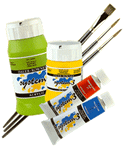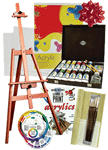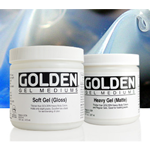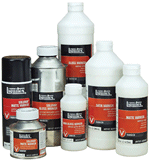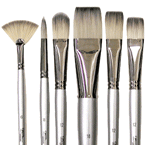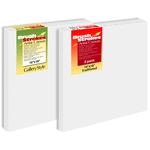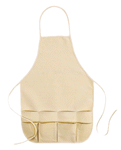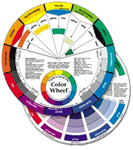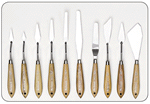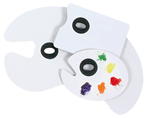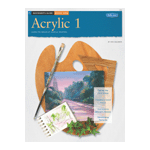GLAZING
APPLICATIONS & TECHNIQUES
DEFINITION
A mixture of acrylic polymer emulsion and acrylic paint that results in a transparent to translucent colored paint film. Used in acrylic painting techniques to create luminous color and depth. Glazes may be used in single or multi-layer color application.
USES
- Acrylic paints and mediums offers the artist a non-toxic system, that is fast driing. This allows many layers of glazing to be done in one day.
- Glazing may be done on any surface that is suitable for acrylic paint.
DIRECTIONS
Mixing
- Mix Professional Grade Medium Viscosity Artists Color into Gloss Medium & Varnish for standard glazes or any transparent or translucent Liquitex Medium for specialty glazes.
- Professional Grade High Viscosity Artists Color may also be used but will take slightly longer to evenly mix into medium.
- Transparent Glazes: 7 -10 parts medium to 1 part color.
- Translucent Glazes: 4 - 6 parts medium to 1 part color.
- The amount of medium added will vary depending upon desired effect and color chosen (colors vary in pigment load and opacity)
- Transparent and translucent colors produce the brightest and clearest colored glazes.
Thinning
Glazes may be thinned up to 25% with water or Flow-Aid Water (1 part Flow-Aid Flow Enhancer, 20 parts water), without affecting clarity or adhesion.
Brush Application
- Do not overwork as this may result in foaming and/or streaking.
Roller application
- Any roller suitable for acrylic paint application may be used. Fine textured rollers and foam rollers distribute the thinnest layer of glaze. Rolling application will result in a bubbly texture.
Multi-Layer Glazes
- Allow each layer to fully dry between coats to avoid clouding. The use of a hair dryer will speed up drying.
Thick Glazes
- When applying multiple layers of thick glazes, make sure the previous application is thoroughly dry before applying next layer of glaze. Extremely thick applications may remain milky because water is trapped within the film.
Less Brushmarks
- To improve the ease of flow during glazing techniques, add 5-25% Flow-Aid Water to Gloss Medium & Varnish glaze.
Refer to Part I Liquitex Paint Additives: Flow-Aid Enhancer.
Increasing Open Time
- Working time varies according to temperature, humidity, absorbency of surface and air flow above surface while working.
- Seal surface prior to glazing with layer of Liquitex Gloss Medium & Varnish or Matte Medium. Unsealed gesso is absorbent and can soak up the first glaze layer, reducing open time.
- Air flowing above surface will make acrylic glazes dry quicker. Close windows and vents if necessary during glazing applications.
- Hot, dry temperatures reduce open time; cool, moist, humid temperatures increase open time.
- Lightly misting surface during application will increase open time.
Appearance when wet and dry
Some mediums may appear milky when wet, but will dry clear. This makes those colors appear less intense, lighter and slightly milky while wet. When dry, colors will be more intense and clear. Before applying to surface, paint a test swatch on similar surface.
Matte Glaze Finish
For a matte glaze finish: mix paint with Gloss Medium & Varnish. When glazing is complete, varnish finished surface with a layer of Liquitex Matte Medium (for matte sheen) or Matte Varnish for a satin sheen. . More than 1 coat of Matte Medium will cloud colors. Do not use Matte Medium for glazing techniques.
GLAZING MEDIUMS
Gloss Medium & Varnish
- Recommended medium to use for standardglazing techniques.
- Dry film clarity produces transparent, brilliant - glazes.
Iridescent Tinting Medium
- Use alone or mix with Gloss Medium & Varnish to create iridescent (opalescent) glazes. Transparent colors and translucent colors work best.
Gloss Gel Medium
- Produces transparent - translucent, heavy, brilliant glazes.
Matte Gel Medium
- Produces translucent - opaque, heavy, matte glazes.
- Mix with Gloss Gel Medium to achieve the desired level of gloss/matte sheen and increase transparency.
Gloss Heavy Gel Medium
- Produces transparent-translucent, extraheavy, brilliant glazes.
Texture Gel Mediums
- Resin Sand Glazes: Mix with Gloss Medium & Varnish to create a "rough" texture, transparent to translucent glazes.
- Glass Bead Glazes: Mix with Gloss Medium & Varnish to create a "reflective bead" texture, transparent to translucent glazes.
- Black Lava Glazes: Mix with Gloss Medium & Varnish to create "black speckled", transparent to translucent glazes.
- Mix the above Texture Gels with any glazing medium for additional effects.
GLAZING ADDITIVES
Flow-Aid Flow Enhancer
- Mix Flow-Aid Water with Gloss Medium & Varnish and Medium Viscosity Concentrated Artist Color to achieve glazes and varnishes that are less sticky and can be brushed on easier with less evident brush marks and more open time for blending.
- Achieve deeper saturation of color in watercolor technique and blending of colors.
- Thins High Viscosity Artist' Color, so that it flows more readily and acts more like Medium Viscosity Concentrated Artist Color. The resulting thinned mixture will have a lower pigment load and therefore lower tinting strength than the Medium Viscosity Concentrated Artist Color.


